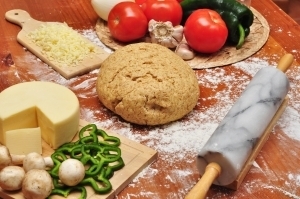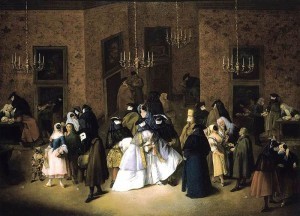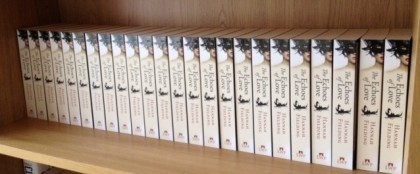Hannah Fielding's Blog, page 116
November 30, 2013
Italian cuisine: A recipe for good health
Cooking is one of my passions in life – particularly making dishes using fresh, home-grown or locally sourced ingredients. When I am in France one of my favourite pastimes is wandering around local markets and stacking my basket high with breads, meats, cheeses, fish and fruits and vegetables, and in Kent my kitchen garden supplies all manner of ingredients for the dinner parties I regularly host.
Though I grew up in Egypt, and now live in France and Kent in England, I am decidedly international in my approach to dining and cooking – I love to try recipes from all the world’s cuisines, and I quite often throw ‘World Food’ parties at which I serve a particular country’s specialties. My new novel, The Echoes of Love, is set in Italy, which provided the perfect excuse for me to get stuck into some Italian cooking – delicious!
The typical Italian daily diet is as follows:
Breakfast (colazione): Coffee (often a frothy sort) or hot chocolate with bread, rolls, pastries, biscotti and jam. Sometimes, cereal and yoghurt.
Lunch (pranzo): The big meal of the day, taken somewhere between midday and two p.m. Lunches are, by tradition, leisurely, although the faster pace of work days squeezes the lunch period for some. To start, antipasto, which may comprise breads, cold meats, cheeses, olives, crudités and dips. Then comes a first course – pasta, risotto or soup – followed by a second course of meat or fish with vegetables. To finish, a traditional desert, if you can manage it, or some fruit.
Dinner (cena): Similar to the lunch menu, but much lighter – could be salad, soup or leftovers from earlier. Most people eat between half past seven and nine p.m.
The arrangement of meals plays a part in healthy digestion. Experts agree that you should consume most of your calories at lunchtime, so that you burn them off with activity in the afternoon.
And what of the cuisine itself? The Mediterranean diet, of which Italian cuisine is a major part, is well known for its health benefits. According to the Mayo Clinic, ‘Research has shown that the traditional Mediterranean diet reduces the risk of heart disease. In fact, an analysis of more than 1.5 million healthy adults demonstrated that following a Mediterranean diet was associated with a reduced risk of death from heart disease and cancer, as well as a reduced incidence of Parkinson’s and Alzheimer’s diseases.’
InItaly, the Mediterranean diet is especially linked to simplicity. Many Italian dishes have only four to eight ingredients. That means ingredients really matter – the better their quality, the tastier and more healthy the food. So if, like me, you love Italian food, here are some staple ingredients that are high on the ‘good for you’ list. Seek out the very best you can find for the most authentic, delicious taste!
Carbohydrates: The Italians don’t shy away from carbs; their diet is rich in breads, pastas and rice (risotto), all of which provide slow-release energy to stop you snacking and, in wholegrain form, have a host of health benefits.
Tomatoes: Vitamin C, Vitamin A, potassium, folate and lycopene (which helps your heart stay healthy and fights off some cancers) – all of these are in the simple tomato. A basic tomato sauce appears in many Italian recipes.
Olive oil: Experts recommend you use this oil for just about all your cooking, and instead of butter. It’s ideal for salad dressings and for sautéing vegetables.
Garlic: The French are perhaps better known for their use of garlic in cooking, but it remains an ingredient in many simple Italian dishes too. Like the tomato, garlic is ideal for cancer prevention and heart health.
Fish: The benefits of a diet rich in fish are well documented. Being surrounded by sea on three sides, Italians very much embrace the rich offerings of the ocean.
Nuts: Monounsaturated fat (good for the heart), protein, fibre, Vitamin E, folate, calcium and magnesium… all in a handful of nuts. Pine nuts are a favourite – try making your own pesto with these at home.
Cheese: Cheese gets a bad press for being fattening, and in large quantities it is. But when it comes to flavourful Italian cheeses, a little goes a long way – and, essentially, a little fat is required in a healthy diet. Parmesan and Grana Padano are firm favourites, as are the soft varieties like mascarpone and ricotta.
You’ll find these ingredients, and others, in the dishes my characters eat in The Echoes of Love, and over the coming months I will post the odd recipe of a dish from the book for you to try at home. Buon appetito!
November 29, 2013
WIN an advance copy of my new novel, The Echoes of Love, this week with Goodreads…
Goodreads Book Giveaway

The Echoes of Love
by Hannah Fielding
Giveaway ends December 06, 2013.
See the giveaway details
at Goodreads.
November 28, 2013
A Kentish walk
November 27, 2013
Recipe: Sicilian Arancini
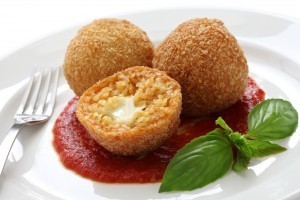 In The Echoes of Love, one of the dishes that my heroine Venetia samples on a date to Sicilian restaurant with Paolo is called arancini. It’s so delicious I thought I’d share with you some details today.
In The Echoes of Love, one of the dishes that my heroine Venetia samples on a date to Sicilian restaurant with Paolo is called arancini. It’s so delicious I thought I’d share with you some details today.
Arancini are essentially golden brown rice balls. The dish dates back a long way in Sicilian history – to around the tenth century – and the name relates to arancina, which is Italian for little orange, the shape of a rice ball. As the chef in the restaurant in The Echoes of Love points out, they are ‘as typical of Sicily as hot dogs and apple pie are of America’. At their most basic, they are balls of rice coated with breadcrumbs and fried, but you can add all sorts of flavours to the rice:
Aubergine
Mozzarella
Mushrooms
Olives
Onions
Peas
Pistachios
Saffron
You can also serve them with sauces, such as ragu, simple tomato, marinara, arrabiata or béchamel. They can be eaten as antipasti, and they’re ideal for using up ingredients you have in the fridge – the rice, for example, need not be freshly cooked. Here’s a simple recipe to try for basic mozzarella balls:
Ingredients:
2 cups rice, cooked and cooled
½ cup finely grated Parmesan
3 eggs
1 ball of fresh mozzarella, cut into chunks
1 cup breadcrumbs (fresh or dried)
Vegetable oil
In a bowl mix together the rice and Parmesan with one egg. Abandon the spoon and dive in with your hands, kneading the ingredients together.
Make eight to ten balls out of the mixture, squeezing firmly into shape.
Press a chunk of mozzarella into the centre of each ball and cover over with so the cheese is hidden inside.
Refrigerate the balls for half an hour so that they firm up.
Beat the remaining two eggs.
Roll each ball in the beaten egg, and then the breadcrumbs.
Fry in hot vegetable or olive oil until golden brown (about five to six minutes), then blot on paper towels.
Serve warm with a sauce of your choice. I find a rocket salad with balsamic dressing works well on the side. Enjoy!
November 26, 2013
Dorsoduro, Venice: Home for a creative soul
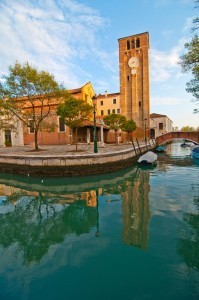 The heroine of my new novel, The Echoes of Love, is English by birth but has settled in Venice, Italy. Venetia is an architect by training, but has specialised in mosaic restoration as an outlet for her passionate and creative side. Thus, what better part of Venice to choose as her home than the Dorsoduro district?
The heroine of my new novel, The Echoes of Love, is English by birth but has settled in Venice, Italy. Venetia is an architect by training, but has specialised in mosaic restoration as an outlet for her passionate and creative side. Thus, what better part of Venice to choose as her home than the Dorsoduro district?
The Dorsoduro is one of the six municipalities (known as sestiere) in Venice – on the southern peninsula. The area is on higher ground than the rest of Venice (its name comes from the Italian for ‘hard ridge’), which means in places one can take in spectacular views over the city and the lagoon. The beauty of the spot is that you escape the crowds and get a slice of the true Venice, while still being within walking distance of the city centre
It is known for being the hub for academic and artistic life in Venice, a beautiful location in which reside artists, writers, designers and thinkers. As I write of the Dorsoduro in the book: Quiet, and more like an island than the touristy areas of the rest of central Venice, it was full of artists and students, hanging out in bohemian cafes and bars, talking, reading, discussing life and art over coffee or a glass of wine. Exactly my kind of place, I confess, and on my last trip to Venice I spent plenty of time ambling through the squares and walkways here, browsing in the many contemporary art galleries and artisan boutiques, and sipping fine coffee in pavement cafes while people-watching. Then there is the Cantinone Gia Schiavi, where you can sample wine and cicheti – the Venetian version of tapas – while looking out on Squero di San Trovaso, watching gondolas being built.
Venetia’s apartment is situated near to the San Nicolo Dei Mendicoli church (pictured), which is sited on one of the first areas of land to have been settled in Venice, back in the seventh century. The current church was built in the twelfth century and dedicated to the fourth-century saint St Nicholas of Myra (Nikolaos the Wonderworker), whose gift-giving made him the model for the modern-day Santa Claus. ‘Dei Mendicoli’ translates to ‘of the Beggars’ – the church was designed to welcome the working classes. The architecture of the church is simple but appealing, if a little melancholic, and inside there are some wonderful ceiling frescos. If you have seen the 1970s thriller film Don’t Look Now, starring Julie Christie and Donald Sutherland, you’ll know the church: it is the one the main character is commissioned to restore.
If you’re able to visit the Dorsoduro, be sure to fit in visits to the following, for which the area is renowned:
Campo San Barnaba and the Ponte dei Pugni, where you’ll find the best shops.
Santa Maria della Salute (see my recent post ‘Madonna of the Salute Festival in Venice’).
Collezione Peggy Guggenheim, full of amazing art by the likes of Max Ernst, Magritte, Brancusi, Arp, Picasso, Dali and Klee.
Galleria dell’Accademia, where you can see works by Veneziano, Bellini, Tintoretto, Lotto, Titian, Veronese and Tiepolo.
Zattere – runs the length of the south side of Dorsoduro along the Canale della Giudecca, and is ideal for an evening stroll (called passeggiata by the Italians).
November 25, 2013
Exclusive: Extract from my new novel, The Echoes of Love
The clock struck midnight just as Venetia went past the grand eighteenth-century mirror hanging over the mantelpiece in the hall. Instinctively she looked into it and her heart skipped a beat. In the firelight she noticed that he was there again, an almost illusory figure, leaning against the wall at the far end of the shadowy room, steady eyes intense, watching her from behind his black mask. An illusory figure indeed, because when Venetia turned around he was gone.
Venetia shivered. Nanny Horren’s voice resounded through her head, reminding her of the strange Celtic superstitions that the Scottish governess used to tell her. One in particular came to mind. ‘Turn off the light and look into the mirror by firelight at midnight on Shrove Tuesday,’ the old woman would whisper to the impressionable and imaginative teenage Venetia, ‘and if you see a face reflected behind your own, it’ll be the face of the love of your life, the man you will marry someday.’
Was this what had just happened to Venetia? Was this stranger the love of her life?
Rubbish, she remonstrated, laughing uneasily into her own eyes, you’re mad! Haven’t you learnt your lesson? Venetia had indulged in such fantasies several years ago and had only managed to get hurt. Now, she knew better. Still, she did not move away. Venetia leant closer to the mirror that reflected her pale, startled face in the flickering light, as tremors of the warm feelings of yester love suddenly flooded her being. For a few moments she seemed to lose all sense of where she was and felt as though she stood inside a globe, watching the wheel of time turning back ten years.
Gareth Jordan Carter. ‘Judd’. It was a diminutive of Jordan, chosen by Venetia who hated the name Gareth and didn’t care much for the name Jordan either. Judd had been her first love, and as far as Venetia was concerned, her last. She had been young and innocent then; only eighteen. Today, at twenty-eight, she liked to think she was a woman of the world, who would not allow herself to be trapped by the treacherous illusions of passion, however appealing they might seem. She had paid a high price for her naivety and impetuosity.
Venetia tried to shake herself clear of those haunting phantasms and her thoughts ambled back to the masked stranger – well, almost a stranger.
Their brief encounter had occurred the evening of the first night of Il Carnevale di Venezia, ten days before Shrove Tuesday …
***
It was nearly seven-thirty and the shops were beginning to shut down for the night. The wind that had blown all day had dropped, and a slight haze veiled the trees, as if gauze had been hung in front of everything that was more than a few feet away. The damp air was soaked with silence.
Venetia tightened the belt of her coat around her slim waist and lifted the fur collar snugly about her neck. The sound of her footsteps echoed off the pavement as she hurried towards the Rialto Bridge from Piazza San Marco, a solitary figure in an almost deserted street. She was on her way to catch the vaporetto water bus, which would drop her off at Palazzo Mendicoli where she had an apartment. A few huddled pedestrians could be seen on the opposite pavement, and there was not much traffic on the great inky stretch of water of the Grand Canal.
Suddenly Venetia saw two figures spring out in front of her from the surrounding darkness. They were enveloped in carnevale cloaks, with no visible faces, only a spooky blackness where they should have been. A hand materialised from under the all-encompassing wrap of one of the sinister creatures and grabbed at her bag. Chilled to the bone, Venetia tried to scream but the sound froze in her throat. Struggling, she hung onto the leather pouch which was looped over her shoulder and across her front as she tried to lift her knee to kick him in the groin, but her aggressors were prepared. An arm was thrown around her throat from the back and the second figure produced a knife.
Just as he was going to slash at the strap of her bag, an imposing silhouette emerged from nowhere and with startling speed its owner swung at Venetia’s attacker with his fist, knocking him off balance. With a grunt of pain the man fell backwards, tripping over his accomplice who gave a curse, and they both tumbled to the ground. Then, picking themselves up in a flash, they took to their heels and fled into the hazy gloom.
‘Va tutto bene, are you alright?’ The stranger’s light baritone voice broke through Venetia’s disoriented awareness, and he looked down anxiously into her large amber eyes.
‘Yes, yes, I think so,’ she panted, her hands going to her throat.
‘Are you hurt at all?’
‘No, no just a little shaken, thank you.’
‘You’re shivering. You’ve had a bad shock and you need a warm drink. Come. There’s a caffeteria that serves the best hot chocolate in Venice, just a few steps from here. It’ll do you good.’ Without waiting for a response, he took Venetia’s arm and led the way down the narrow street.
Venetia’s knees felt like jelly and her teeth were chattering. ‘Thanks,’ she murmured, still trying to catch her breath, her heart pounding, and let herself be guided by her tall, broad-shouldered rescuer, who seemed to have taken the situation into his hands.
Thus does Fate cast her thunderbolts into our lives, letting them fall with a feather-like touch, dulling our senses to the storm they would cause should we realise their devastating powers.
They sat in silence at a table in a far-off corner of the crowded caffeteria. There was too much noise to talk and Venetia was exhausted, so she concentrated on appraising the man sitting opposite her as she listened to the music playing: Mina’s nostalgic 1960 love song, ‘Il Cielo in una Stanza’, the unashamedly romantic hit that was so Italian, and which was therefore still frequently played as a classic all over the country.
Venetia’s guardian angel looked more like Lucifer than a celestial being, with his tempestuous blue eyes, curiously bright against the warm tan of his skin, which slanted a fraction upwards under heavy, dark brows when he smiled. They were staring intently at her now with an emotion which puzzled her, and for a few seconds she found herself helplessly staring back into them. It was like gazing into shimmering water.
Strong, masculine features graced his nut-brown face beneath a thick crop of raven-black hair, sleek and shining, swept back from a wide forehead. He wasn’t good-looking in the classical sense, his face was too craggy for that immediate impact, but he was a striking man who emanated controlled power, someone used to making decisions who would not be swayed by any argument or sentiment; a hard man. Still, his steeliness was tempered by the enigmatic curve that lifted the corners of his generous mouth into a promise of laughter; this, coupled with the deep cleft in the centre of his chin, gave him a roguish expression that Venetia found appealing.
The waiter brought over a cup of hot chocolate, a double espresso and a plate of biscotti which he said were offered con i complimenti della casa. Her rescuer was obviously a regular customer.
Venetia took a few sips of the thick, warm brew. She felt herself revive as it trickled down her throat, becoming a warm glow in her stomach which reflected on her cheeks.
The stranger smiled at her. ‘Feeling better?’
She nodded. ‘Thank you, you’ve been so very kind.’
His smile broadened. ‘You are welcome, signorina. It is always a pleasure to come to the rescue of a beautiful lady. My name is Paolo Barone, at your service.’
Venetia had been working in Italy for over three years as an architect cum interior designer in her godmother’s architect firm, and was used to the gallant ways and the charm of Italian men. She found their smooth repartee refreshing, and sometimes even amusing, but never took them too seriously. Paolo Barone was different. Maybe it was because she was in shock and felt vulnerable, but nevertheless her heart warmed to this man, who, although not that young, was still in his prime – middle to late thirties perhaps – and she relaxed. Still, even though the circumstances in this case were unusual, Venetia was not used to accepting invitations from strangers, so she deliberately made no conversation; and to her surprise neither did he.
As she raised the warm cup to her lips with both hands, she was aware of him looking at her directly with unabashed interest. Was he trying to decipher her, she wondered? Relieved that the hot drink’s effect on her cheeks was hiding the slight confusion she felt beneath, she sipped a little too quickly and cooled her lip with the tip of her tongue. Then realising what she had done, she glanced up to see his expression deepen into something else, which made her instantly lower her eyes.
When she had finished her chocolate, Paolo smiled at her. ‘Andiamo? Shall we go?’ he asked, cocking his head to one side and looking at Venetia with curiosity.
Sparkling hazel eyes flecked with gold smiled back at him through long black lashes that somehow did not belong with her chestnut hair. ‘Yes. Thank you for the hot chocolate. It is really the best chocolate I’ve had in Venice.’
He helped her with her coat, lifting her glorious long locks over the fur collar. At five foot seven inches, Venetia was tall but as he faced her and began buttoning the garment himself, she noticed again how he towered over her. His hands were strong and masculine; she had a curious sensation of warm familiarity, as though he had performed this act with her several times before. Yet mingled with that feeling came one of embarrassment; his touch seemed a rather intimate gesture instead of the impersonal indifference of a stranger, and she drew away with a little nervous laugh.
‘Thank you, that won’t be necessary.’
He held her gaze intently for a moment, as if surprised at what she had said, and she looked down again, for some reason unable to meet those midnight-blue eyes and their burning intensity. Then he smiled and held the door open.
‘By the way, I don’t know your name,’ Paolo said as they stepped out into the misty night and began walking towards the Grand Canal.
‘Venetia. Venetia Aston-Montagu.’
He quirked a black eyebrow. ‘A very romantic name, Venetia, like our beautiful city. But you’re not Italian? You speak Italian like a native.’
She laughed. ‘Thank you for the compliment. No, I’m actually English, but I was named by my godmother, who is Venetian. She was my mother’s best friend and she insisted I learn Italian.’
‘So you’re on holiday here?’
‘No, I live here.’
‘Nearby?’
‘No, in the Dorsoduro district. I need to catch the vaporetto, as the entrance to the building where I live is on the Grand Canal.’
‘My launch is moored across the street. Dorsoduro is on my way. It would be a pleasure for me to drop you off.’
‘No, thank you. You’ve already been very kind.’
‘It’s late and snow has been forecast for tonight. The vaporetto is bound to be almost empty. I wouldn’t want you to come to any harm, signorina. I will give you a lift.’ He spoke quietly with an air of command, his hand coming up to her elbow, but she avoided it hastily.
It was very tempting to accept, but Venetia would not let herself. This stranger was a little too attentive, she thought, and though she had been grateful for his kind invitation to a hot chocolate when she was in distress, and could still recall the feel of his hands buttoning up her coat, she was not in the habit of being picked up by men.
‘No really, thank you very much. I’m used to travelling by vaporetto. It’s quite safe.’
Paolo did not insist, and for the rest of the way they walked in silence through the narrow, tortuous alleys, Venetia conscious of his nearness in every fibre of her being.
It was bitterly cold. The wind was whistling and a bank of threatening cloud hung over Venice like a white cloak. As they arrived at the waterbus stop, a few snowflakes started to come down. A couple of gondolas, their great steel blades looming dangerously out of the soft velvety mist, glided by swiftly over the gently lapping waters.
‘Are you sure you don’t want to change your mind? It looks as though there’ll be a blizzard and the vaporetto may be delayed.’ He looked at her with a polite, but guarded smile and she felt a momentary pang of regret at her determination to escape him.
Paolo’s pride was spared a new refusal as they heard the croaky purr of the vaporetto announcing its lazy approach.
‘Here comes my bus,’ Venetia said cheerfully. ‘I’ll be home in no time.’
The boat appeared and presently drew up at the small station, bumping the landing stage as it did so.
‘Thanks again for all your help, signore,’ she went on, smiling as she held out her small, perfectly manicured hand to say goodbye. The young man took it in his own, which was large and warm, and held it a trifle longer than would be usual. Venetia stood there with waves of heat passing over her, her senses suddenly heightened at this contact. She abruptly withdrew her hand.
His blue hawk eyes gazed down at her, intent though unfathomable, and he paused uncertainly. ‘Will you dine with me tomorrow night?’ he uttered in a low voice.
It would be exciting to dine with Paolo, she thought, but you must run from him, urged the echo of an insistent voice within her; this man has the power to hurt you.
‘I’m so sorry,’ she replied stiffly. ‘I’m afraid I’m busy.’
‘That’s a pity.’ He sounded as if he meant it, but did not insist, leaving her feeling curiously disappointed. He held out his hand again, silently, and she took it, also without a word. There was nothing lax or vague in his firm grasp. Like many people, Venetia was swift to gauge character by the quality of a handclasp and had known many apparently vigorous men whose fingers were like limp fish. Once more, she was aware that Paolo’s large, sensitive hands held a strength and vitality that stirred her deeply.
She hurried onto the vaporetto, suddenly eager to flee, but as the waterbus pulled away from the quay, she watched him go up the stairs and disappear into the snow-white night with a strange sinking of the heart, wondering if she would ever see him again.
November 23, 2013
The Venetian masquerade: A haunting artwork
My new novel, The Echoes of Love, opens on the evening of the famous and flamboyant Venice Carnival, in which the city comes alive with revellers, many of whom attend masquerade parties and don the masks that are so much a part of Venetian heritage.
The hero, Paolo, and the heroine,Venetia, first cross paths during that time and it is at such a party that they meet again, each shrouded in mystery – the mask concealing the true form, and creating an at once unsettling and alluring distortion.
In writing the masquerade party scene, I often had in my mind the painting ‘Il Ridotto’ by Venetian artist Pietro Longhi (1702–1785). Indeed, Venetia herself thinks of the painting upon entering the surreal scene; and she recalls the artwork as being ‘spooky, with its macabre eighteenth-century figures disguised in masks and shrouded in shadows’.
In fact, ‘Il Ridotto’ depicts a scene in a gambling hall in Venice – these were quite the rage in the 1750s, in which era the painting is set. The figures are a mixture of masked and unmasked, but it is to the masked characters that the eye is drawn – specifically, the central couple. The woman is demure and innocent in white; her counterpart – dark but for his ghostly mask – is lifting her dress. The meaning in the painting is tangible: through wearing the masks, inhibitions are cast aside and deepest desires come into play. Here, in a single work, is one of the foundation’s of Venetian romance laid bare. Here is exactly why I chose to begin my novel during the Carnival, during a masquerade: the perfect atmosphere from which to build a story of romance and passion, but with a dark undercurrent of deceit and mystery lurking beneath, ready to shatter at any moment the fragile awakenings of love.
Were I to choose an artist to represent the dark side of The Echoes of Love, Pietro Longhi would be he. Although he began his painting career creating religious-themed works, he grew increasingly well known for his depictions of Venetians at play, and many of his works included somewhat sinister, puppet-like figures who were rendered faceless by the Carnival masks they wore. Art critics infer that these figures (which make up around half of all those in his genre paintings) are all of the upper classes, and the masks are a source of liberation for them. Certainly, the proliferation of masks create a strong sense of duality in the artworks, which pulls you in, as the viewer, to really explore the meaning behind the paintings – surely the mark of the best of art.
If, like me, you find the masquerade compelling, you’ll perhaps enjoy this clip from the most recent film version of The Phantom of the Opera: the setting is Parisian, but the influence in the costumes distinctly Venetian – and what passion!
November 22, 2013
Book review: Regret Not a Moment by Nicole McGehee
From the blurb:
The year is 1930. Beautiful, witty Devon is the daughter of a prominent Virginia family. Many men have fallen under her spell, but none has captured her heart, until she meets New York tycoon John Alexander. Their future seems assured: they will marry, raise a family, turn their country estate into the best Thoroughbred farm in the nation. But what Devon cannot foresee are the conflicts that will drive away her husband or the tragedy that will devastate their marriage.
Be transported from lush Virginia hunt country to sophisticated New York and the embassies of Paris. Travel from the Hollywood glamour of Hearst castle in its heyday to the turmoil of war-torn Cairo, and the enclaves of aristocratic England. Devon’s tale takes you through the decades from peaceful pre-war America to the danger of World War II, and the racial unrest of the South of the 1950s and’60s.
Enjoy the thrill of Thoroughbred racing with one of the first women to break into the male-dominated sport and one of the first African-American men to become renowned as a world-class trainer.
Sublime writing and heartfelt romance.
There’s much to love in this book:
The writing style, which is effortless to read and highly evocative.
The romance, which is wonderfully true to life and mature.
The poignancy, which had me reaching for the tissues.
The settings, which are painted so richly one feels transported to the times and places.
The eras depicted, which add such layers of depth and meaning to the book.
The ‘epic’ feel the story, which makes for very satisfying reading of a story spanning some years.
The characters, who are so easy to empathise with; especially the heroine, who is to be admired for her resilience and strength.
The plot, which is intelligent and gripping – I especially loved the family connections and the exploration of the horse-racing world.
In all, a book I highly recommend for first-class escapism.
Regret Not a Moment is available now from Amazon; click on the book cover below to visit the store.
November 21, 2013
Madonna of the Salute Festival in Venice
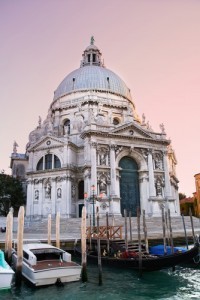 In Venice, the Basilica di Santa Maria della Salute (known as the Salute) is an emblem of the city – a 17th-century Baroque Roman Catholic church in the Dorsoduro area that is a well-known landmark, visible from the Grand Canal and the Piazza San Marco for its mighty domed roof. It was built following a devastating plague in the city, as an offering to God for delivering the city from the terrible disease at last.
In Venice, the Basilica di Santa Maria della Salute (known as the Salute) is an emblem of the city – a 17th-century Baroque Roman Catholic church in the Dorsoduro area that is a well-known landmark, visible from the Grand Canal and the Piazza San Marco for its mighty domed roof. It was built following a devastating plague in the city, as an offering to God for delivering the city from the terrible disease at last.
On 21 November, Venetians celebrate the Festa della Madonna della Salute (Madonna of the Salute Festival), in which people parade from San Marco to the Salute to participate in a service that remembers those who died in the plague and offers thanks to God for saving the city. Santa Maria della Salute means ‘Our Lady of Health’.
You may wonder, all these years on, why Venetians still remember the plague of 1630–1. It is because it claimed the lives of almost a third of the population (100,000 Venetians), leaving a terrible scar on the city. At the time all known medicines failed to make any difference, leaving those who survived no option but to turn to God for their salvation. Some 10,000 survivors made a pilgrimage around Piazza San Marco for three days and nights, and it is in these footsteps that the modern-day procession follows.
The festival is popular with Venetians, who flood the streets from morning until night to follow the lead of the Archbishop of Venice. They cross a temporary pontoon bridge set up across the Grand Canal to link Campo Santa Maria del Giglio to La Salute. The bridge is quite a sight to behold: resting on eight tethered barges between which vaporetti (water buses) squeeze through.
Visitors are most welcome to join in – nonbelievers and believers alike; for this is a festival about health, first and foremost. You’ll find an array of vendors offering treats along the way, from cakes to candy floss, plus tall candles that you can light in remembrance once inside the Salute.
Once you’ve made the journey, the custom is to eat castradina– a cabbage and mutton stew – in memory of the loyal Dalmatians, who were the only state to provide Venice with sustenance during the plague in the form of the one foodstuff they had access to: mutton. The recipe is really very simple but tasty: smoked mutton boiled for three hours, with browned Savoy cabbage and onion added after two hours.

